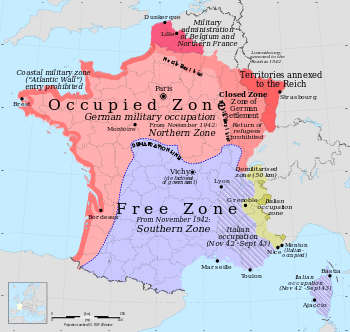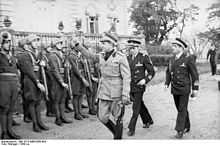Italian occupation of France during World War II
| Italian Military Administration in France Amministrazione Militare Italiana di Francia | ||||||
| Military Administration of the Kingdom of Italy | ||||||
| ||||||
| ||||||
 Italian Military Administration in France:
| ||||||
| Government | Military Administration | |||||
| Historical era | World War II | |||||
| - | Italian invasion | 10 June 1940 | ||||
| - | Italian armistice | 8 September 1943 | ||||
Italian-occupied France was an area of south-eastern France occupied by Fascist Italy in two stages during World War II. The occupation lasted from June 1940 until the Armistice between Italy and Allied armed forces on September 8, 1943, when Italian troops on French soil retreated under pressure from the Germans.
Italian occupation
The initial Italian occupation of France territory occurred in June 1940; it was then expanded in November 1942.

The German offensive against the Low Countries and France began on 10 May and by the middle of May was on French soil. By the start of June, the British were evacuating from the pocket in Northern France. On 10 June 1940, Italy declared war against the French and British. Ten days later, the Italian army invaded France. During the fighting, the Italians lost 631 men killed and 2,631 wounded, with an additional 616 reported missing. A further 2,151 men were stricken by frostbite during the campaign. French losses amounted to 229 casualties. On 24 June 1940, after the Fall of France, Italy and France signed the Franco-Italian Armistice, two days after the Second Armistice at Compiegne between France and Germany, agreeing upon an Italian zone of occupation.
This initial zone of occupation was 832 km² and contained 28,500 inhabitants.[1] The largest town contained within the initial Italian zone of occupation was Menton, annexed officially to the Kingdom of Italy.[1] The main city inside the "demilitarized zone" of 50 km from the former border with the Italian Alpine Wall [2] was Nice.[3]
In November 1942, in conjunction with Case Anton, the German occupation of most of Vichy France, the Royal Italian Army (Regio Esercito) expanded its occupation zone. Italian forces took control of Toulon and all of Provence up to the river Rhône, with the island of Corsica (claimed by the Italian irredentists). Nice and Corsica were to be annexed to Italy (as had happened in 1940 with Menton), in order to fulfil the aspirations of Italian irredentists (including local groups such as the Nizzardo Italians and the Corsican Italians).[4] But this was not done because of the Italian surrender to the Allies in September 1943 when the Germans took over the Italian occupation zones.
Characteristics
Overall, the Italian forces numbered about 700,000 troops in June 1940. However, while they enjoyed a huge numerical superiority to the French, they had several deficiencies. The Italian armored regiments were from the 133 Armoured Division Littorio and included between 150 to 250 L3/35 tankettes which were little more than lightly armored machine-gun carriers not suited for modern warfare. Most Italian units had inadequate or obsolete artillery and lacked motor transport. Specific to this front, the Italians were not equipped for the cold Alpine environment, and faced the formidable fortifications of the Alpine Line (called the "Little Maginot").
The Italian Army of occupation in southern France in November 1942 was made up of four infantry divisions with 136,000 soldiers and 6,000 officers, while in Corsica [5] there were 66,000 soldiers with 3,000 officers.[6] They faced no opposition from the Vichy Army.
There was virtually no guerrilla war against the Italians in France until summer 1943.
Refuge
Many thousands of Jews moved to the Italian zone of occupation to escape Nazi persecution in Vichy France. Nearly 80% of the remaining 300,000 French Jews took refuge there after November 1942.[7] The book Robert O. Paxton's Vichy France, Old Guard, New Order describes how the Italian zone acted as a refuge for Jews fleeing persecution in Vichy France during the occupation.
The Italian Jewish banker Angelo Donati had an important role in convincing the Italian civil and military authorities to protect the Jews from the French persecution.[8]
In January 1943 the Italians refused to cooperate with the Nazis in rounding up the Jews living in the occupied zone of France under their control and in March prevented the Nazis from deporting Jews in their zone. German foreign minister Joachim von Ribbentrop complained to Mussolini that "Italian military circles... lack a proper understanding of the Jewish question."[9]
However, when the Italians signed the armistice with the Allies, German troops invaded the former Italian zone (September 8, 1943) and initiated brutal raids. Alois Brunner, the SS official for Jewish affairs, was placed at the head of units formed to search out Jews. Within five months, 5,000 Jews were caught and deported.[10]
Mussolini even had a Jewish mistress, Margherita Sarfatti, and refused to hand over Jews in Italian-occupied Europe to the Nazis.[9][11]
Bordeaux
In August 1940, the Italian Royal Navy (Regia Marina) established a submarine base at Bordeaux, outside Italian-occupied France.[12]
Operating from Bordeaux Sommergibile ("BETASOM") as it was known, thirty-two Italian submarines participated in the Battle of the Atlantic. These submarines sank 109 Allied merchant ships (593,864 tons) and 18 warships (20,000 tons) up to September 1943.[13]
Italian territorial claims
In addition to Nice/Nizza and Corsica, the Italians projected further territorial claims for the defeated France. In 1940, The Italian Armistice Commission (Commissione Italiana d'Armistizio con la Francia, CIAF) produced two detailed plans concerning the future of the occupied French territories.[14] Plan 'A' presented an Italian military occupation all the way to the river Rhone, in which France would maintain its territorial integrity except for Corsica and Nizza.[14] Plan 'B' encompassed the Italian annexation of the Alpes Maritimes (including the Principality of Monaco) and parts of Alpes-de-Haute-Provence, Hautes Alpes and Savoie.[14] The territory would be administrated as the new Italian region of Alpi Occidentali with the town of Briançon (Italian: Brianzone) acting as the provincial capital.[14]
See also
- Italian invasion of France
- Alpine Wall
- Alpine Line
- Military history of Italy during World War II
- Italian-occupied Corsica
References
- ↑ 1.0 1.1 Militärgeschichtliches Forschungsamt. Germany and the Second World War – Volume 2: Germany's Initial Conquests in Europe, pg. 311
- ↑ The Fortifications of the Alpine Wall
- ↑ Photos of Italian occupation of Nice
- ↑ Unredeemed Italy (Google Book)
- ↑ Photo of Italian troops in Corsica
- ↑ Giorgio Rochat, Le guerre italiane 1935–1943. Dall'impero d'Etiopia alla disfatta p. 376
- ↑ Salvatore Orlando, La presenza ed il ruolo della IV Armata italiana in Francia meridionale prima e dopo l’8 settembre 1943, Ufficio Storico dello Stato Maggiore dell’Esercito Italiano, Roma (in Italian)
- ↑ From the French Shoah memorial : Angelo Donati’s report on the steps taken by the Italians to save the Jews in Italian-occupied France
- ↑ 9.0 9.1 Italy and the Jews – Timeline by Elizabeth D. Malissa
- ↑ Italians and Jews in Nice 1942/43
- ↑ "Italian Fascism Didn't Practice Anti-Semitism". The New York Times. December 22, 1993.
- ↑ Betasom (in Spanish)
- ↑ Ghetti, Walter. Storia della Marina Italiana nella seconda guerra mondiale p. 26
- ↑ 14.0 14.1 14.2 14.3 Davide Rodogno (2006). Fascism's European empire: Italian occupation during the Second World War. Cambridge University Press. pp. 89–92. ISBN 0-521-84515-7.
Further reading
- Ghetti, Walter. Storia della Marina Italiana nella seconda guerra mondiale. (Volume secondo). De Vecchi editore. Roma, 2001
- Rainero, R. Mussolini e Petain. Storia dei rapporti tra l'Italia e la Francia di Vichy. (10 giugno 1940-8 settembre 1943), Stato Maggiore dell'Esercito-Ufficio Storico, Roma, 1990
- Rochat, Giorgio. Le guerre italiane 1935–1943. Dall'impero d'Etiopia alla disfatta Einaudi editore. Torino, 2002
- Schipsi, Domenico. L'occupazione Italiana dei territori metropolitani francesi (1940–1943), Stato Maggiore dell'Esercito-Ufficio Storico, Roma, 2007
- Varley, Karine. 'Between Vichy France and Fascist Italy: Redefining Identity and the Enemy in Corsica during the Second World War', Journal of Contemporary History 47:3 (2012), 505–27.
| ||||||||||||||||||||||
.svg.png)
.svg.png)